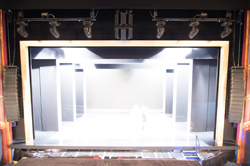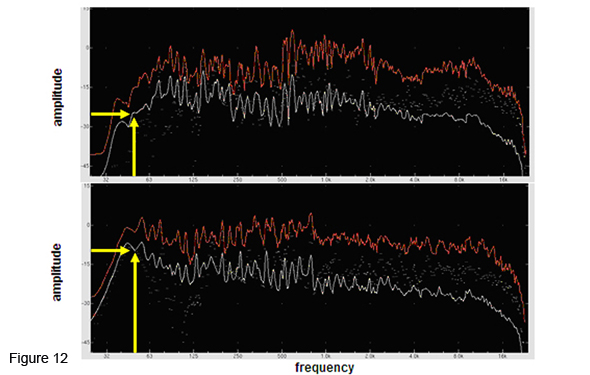
Demands Of Modern Music
So what parameters do we need to set for linear behavior in our desired audio reinforcement system?
First, we need to set bandwidth, and ideally that would be about 30 Hz to 18 kHz, perhaps even wider in the electrical stages.
Now, here’s the critical part. We need the loudspeaker system to respond to the signal demands all across that frequency bandwidth in a linear fashion, regardless of the input signal.
For example, let’s look at spectrum measurements for two pop songs. For each, the top red trace is the peak value, and the white trace is the RMS level, both averaged over one minute.
The top screen is that of a 1970s pop hit, the bottom screen shows a newer pop tune. At 50 Hz, there’s a level difference of almost 15 dB, or almost six times louder.
That means you’d need a little more than 30 times more power to realize linear reproduction of the newer song if the mids and highs for both songs were reproduced at the same levels (Figure 12).
That calculation is important. Remember, Decibels are logarithmic ratios, dB = a X log(x/y), where a is either 10 (power or intensity) or 20 (sound pressure or voltage), and x and y are values like 0.5 volts and 1.0 volt.
For our example, here’s how it works out:
Sound pressure (dB) = 20 log (x) x = amplitude change factor or ratio
15 dB = 20 X log (x)
x = 5.6 times louder
Power (dB) = 10 log (y) y = power change factor or ratio
15 dB = 10 X log (y)
y = 31.6 times more power
And if you want to project that level across a distance of 100 meters (approximately 330 feet), you need a prodigious amount of power. With that in mind, it’s easy to see why large-scale reinforcement systems often are driven well into their non-linear regions.
But is that the right approach? Some live sound mixers overdrive certain systems to “get their sound.” Is that a role that should be played by a loudspeaker system? And what if it works for one artist, and not another? Does it really make sense to have one system for heavy metal, another for jazz, and a third for classical? Can you count on a system’s consistent performance when it does not behave in a linear manner?
Art Or Science?
Here we need to acknowledge – and applaud – the legitimate and deliberate creation of audio non-linearity for artistic effect. Certainly the output of Jimi Hendrix’s Marshall stack was not a linear transfer of the string sound on his Fender Strat. And today’s live sound engineers have at their disposal a vast array of tools – from digital console plug-ins to racks of vintage outboard gear – to create entire universes of non-linear sounds to express an artistic vision.
But once that artistic intent is realized, usually at the output of the mixing console, the sound reinforcement system should transmit that sound transparently, coherently and consistently. And regardless of the frequencies and sound levels, the loudspeaker system should not alter the sonic characteristics of the source at any point during a show. The end result should be, to the greatest extent possible, a linear translation of that small electrical input into a very powerful acoustic output.
A linear system puts more of the artistic control in the hands of the artists. So if the artist and live sound mixer decide to change a squirrel-sound into a banana-sound, that’s how it should be. That’s the role of art.
However, the goal of the sound reinforcement system is to make sure that everyone in the audience hears and enjoys exactly the same, undiluted banana-sound experience. And that’s a job for science.
Peter Soper is R&D engineer and Steve Bush is senior technical support specialist for Meyer Sound.

